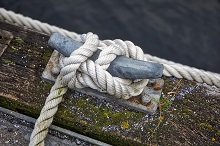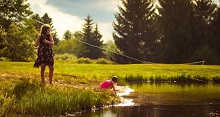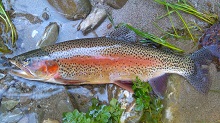Salmon Runs Vary Greatly Over Centuries
Canadian Angling (Feb. 10, 2013) Researchers have recently found that salmon runs, vary considerably over the centuries. In the past 20 years, they recognized that the salmon stocks vary yearly and some have 10 year long cycles, but their research has found that they actually may vary from one century to another. A good example is the 30 to 60 year variations in the salmon runs in the West Coast and Alaska that they believe is driven by the climate pattern known as Pacific Decadal Oscillation.
Researchers (University of Washington) have found that the decade cycles may actually be century’s long conditions that effect fish productivity. They found cycles lasting 200 years while examining 500 year records in southwest Alaska and some of the variations as high as those from human harvesting of salmon.
The researchers examined core samples taken from 16 sources in south western Alaska. They measured the amount of nitrogen in the sediment that was deposited by dieing salmon. The type of nitrogen that they measured was absorbed by the salmon in the oceans before heading up the rivers to spawn.
Lauren Rogers (UW) said: “We’ve been able to reconstruct what salmon runs looked like before the start of commercial fishing. But rather than finding a flat baseline — some sort of long-term average run size — we’ve found that salmon runs fluctuated hugely, even before commercial fishing started. That these strong or weak periods could persist for sometimes hundreds of years means we need to reconsider what we think of as ‘normal’ for salmon stocks.”
Co-author professor Daniel Schindler (UW)said: “Surprisingly, salmon populations in the same regions do not all show the same changes through time. It is clear that the salmon returning to different rivers march to the beat of a different — slow – drummer. The implications for management are profound. While it is convenient to assume that ecosystems have a constant static capacity for producing fish, or any natural resource, our data demonstrate clearly that capacity is anything but stationary. Thus, management must be ready to reduce harvesting when ecosystems become unexpectedly less productive and allow increased harvesting when ecosystems shift to more productive regimes.
He went on to add that: “Management should also allow, and probably even encourage, fishers to move among rivers to exploit salmon populations that are particularly productive. It is not realistic to assume that all rivers in a region will perform equally well or poorly all the time.”
Rogers said: “We expected to detect a signal of commercial fishing — fisheries remove a lot of the salmon, and thus salmon nitrogen, that would have otherwise ended up in the sediments. But we were surprised to find that previous returns of salmon to rivers varied just as dramatically. Interestingly these same fluctuations also highlight that salmon stocks have the capacity to rebuild naturally following prolonged periods with low densities, suggesting a strong resilience of salmon to natural and anthropogenic depletion processes. Indeed, total salmon production (catch plus escapements) has been relatively high in recent years for most sockeye salmon stocks in southwestern Alaska, despite a century of intense harvesting.”
Co-authors include Peter Lisi and Gordon Holtgrieve with the UW, Peter Leavitt and Lynda Bunting with University of Regina, Canada, Bruce Finney with Idaho State University, Daniel Selbie with Fisheries and Oceans Canada, Canada, Guangjie Chen with Yunnan Normal University, China, Irene Gregory-Eaves with McGill University, Canada, and Mark Lisac and Patrick Walsh with Togiak National Wildlife Refuge, Alaska, Jan 14 Proceedings of the National Academy of Sciences.
Wayne Sheridan for Canadian Angling.com



